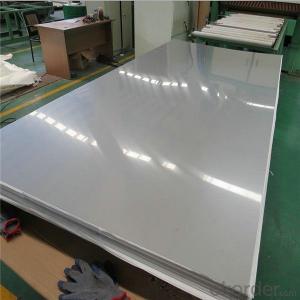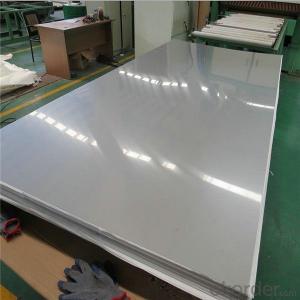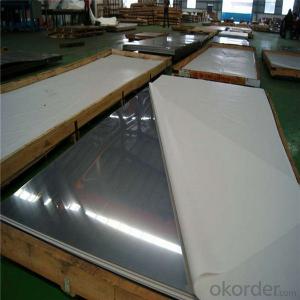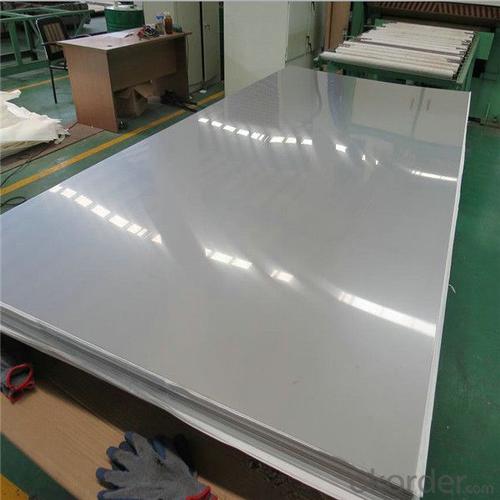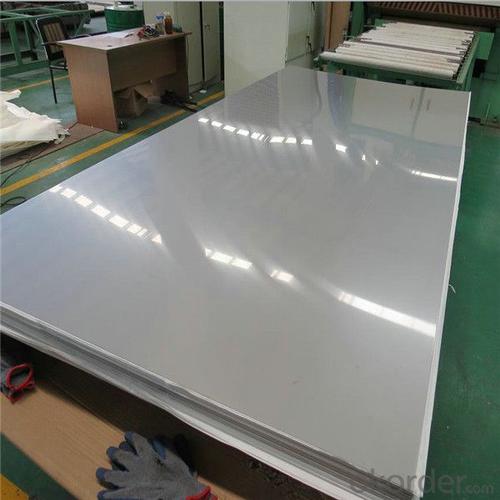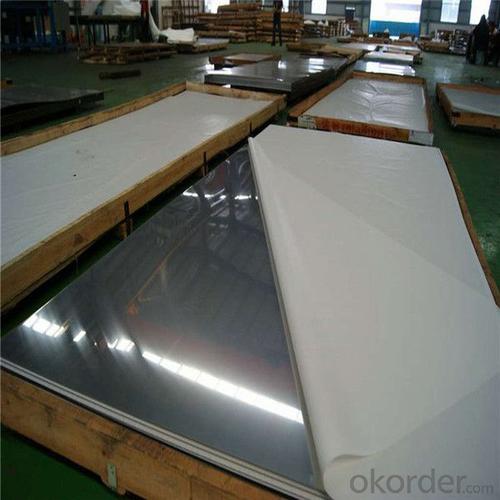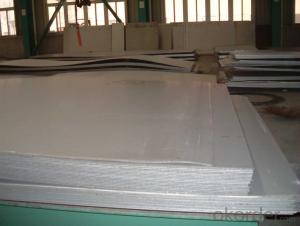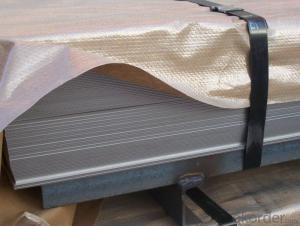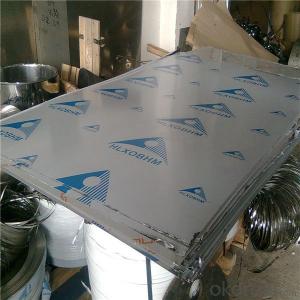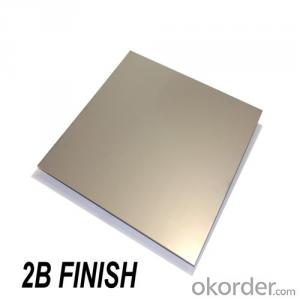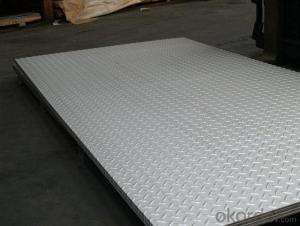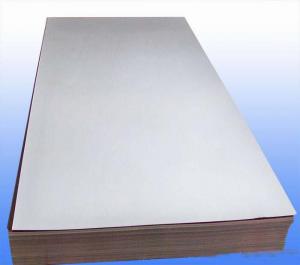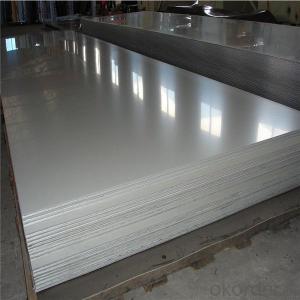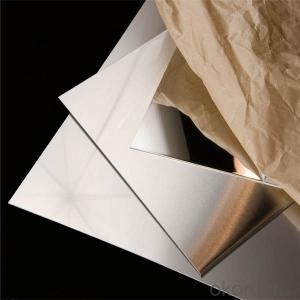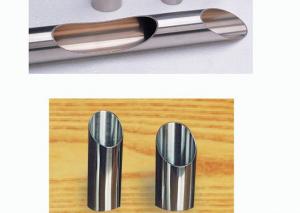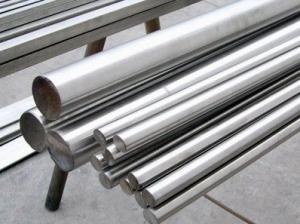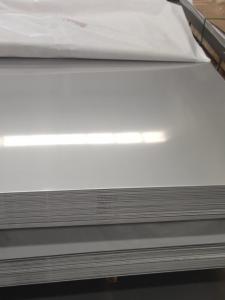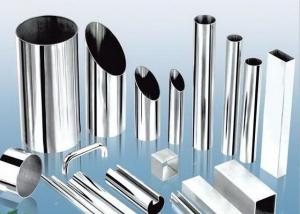Stainless Steel Sheet ASTM/AISI/JIB 304 2mm
- Loading Port:
- Shanghai
- Payment Terms:
- TT OR LC
- Min Order Qty:
- 2 m.t.
- Supply Capability:
- 2000 m.t./month
OKorder Service Pledge
OKorder Financial Service
You Might Also Like
Specification
Stainless Steel Sheet ASTM/AISI/JIB 304 2mm
Features:Stainless Steel Sheet ASTM/AISI/JIB 304 2mm
1.Accurate dimension
2.Minimum mainenance
3.Excellent service life
4.Non Corrosive
5.Heat Resistant
Detail information Stainless Steel Sheet ASTM/AISI/JIB 304 2mm:
1. Steel grade: 304
2. Surface: 2B, BA, No. 4, 8K(mirror), HL, embossing, etching. And more than 100 different patterns for your choice.
3. Colors: Golden, rose golden, titanium golden coating, champagne golden, brown, bronze, titanium black, sapphire blue, purple, gray, silver, coffee champagne, jade-green, etc.
4. Thickness: 0.3-120mm
5. Width: 500mm, 1000mm, 1219mm, 1500mm, 1800. And length: Could be cut into any size as per customer's request. Usually our common sizes: 1219mm*2438mm (4*8ft), 1219mm*3048mm (4*10ft) and 1000mm*2000mm.
6. Standard: AISI, SUS, etc.
7. Competitive Advantages of the product
1) Stainless Steel Decorative Sheet
2) Customize pattern and color coating
3) Advantage: Various patterns, splendid decorative effect, fashionable design
4) Surface finish: Mirror, 2b, no.1, no.4, 6k, 8k, polished, etc
1. Material: 304
2. Standard: ASTM, AISI,JIS, DIN,GB
3.Cold rolled stainless steel sheet
Thickness : 0.3mm-3.0mm
Width : 1000mm/1219mm/1500mm
Length : 2000mm/2438mm/4000mm/6000mm or cutting randomly
Model size : 0.3mm-3.0mm(TK)*1000mm(W)*2000mm(L)
0.3mm-3.0mm(TK)*1219mm(W)*2438mm(L)
0.3mm-3.0mm(TK)*1500mm(W)*4000mm(L)
Surface : 2B, BA, 8K, HL, 2D, Golden 8K, Black 8K etc.
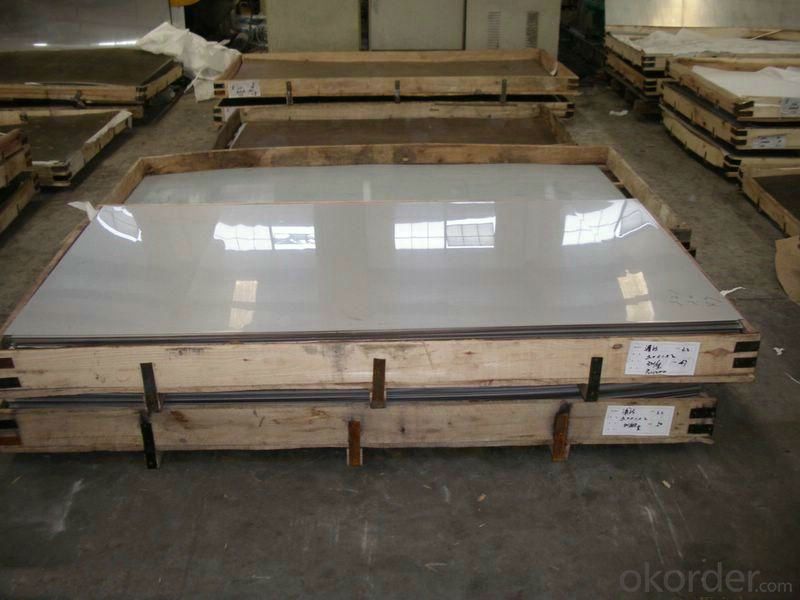
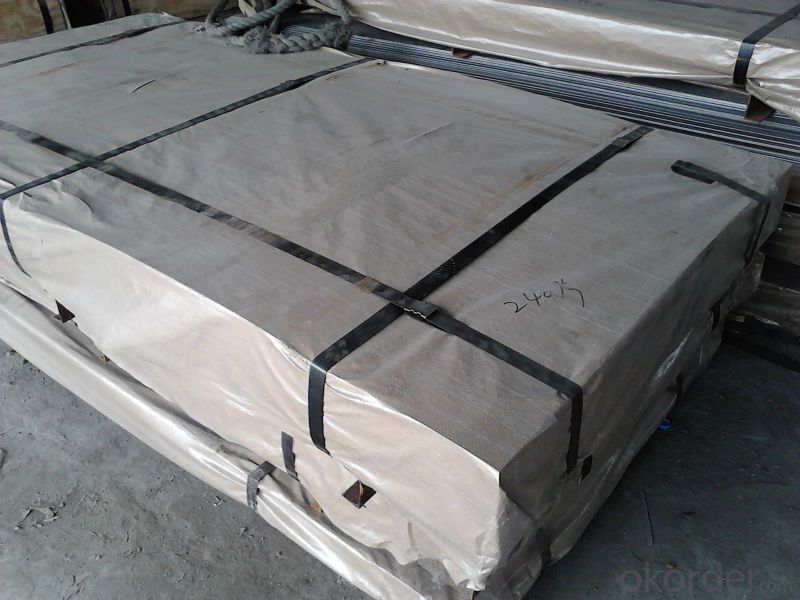
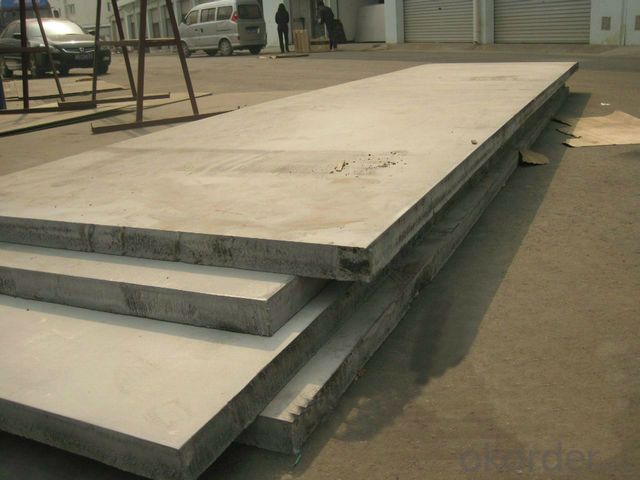
5.Characteristics and application
Surface finish | Characteristics and application |
NO.2B | The surface brightness and flatness of no2B is better than no2D. then through a special surface treatment to improve its mechanical properties,No2B could nearly satisfy comprehensive uses. |
NO.3 | Polished with abrasive belt of git#100-#200, have better brightness with discontinuous coarse stria, used as inner and external ornaments for building, electrical appliances and kitchen utensils etc. |
NO.4 | Polished with abrasive belt of grit #150-#180,have better brightness with discontinuous coarse stria,but thinner than No3, are used as bathtub buildings inner and external ornaments electrical appliances kitchen utensils and food processing equipment etc. |
HL | Polished with abrasive belt of grit #150-#320 on the NO.4 finish and has continuous streaks, mainly used as buildings ornaments elevators,door of building, frontal plate etc. |
BA | Cold rolled, bright annealed and skin-passed, the product have excellent brightness and good reflexivity like mirror,kitchen apparatus,ornament etc. |
8K | The product have excellent brightness and prefer reflexivity can to be the mirror. |
- Q: Can stainless steel sheets be used in the construction industry?
- Yes, stainless steel sheets can be used in the construction industry. They are commonly used for a variety of applications including roofing, cladding, structural supports, and interior finishes. Stainless steel offers excellent corrosion resistance, durability, and aesthetic appeal, making it a popular choice for construction projects.
- Q: How do I calculate the strength of stainless steel sheets?
- To determine the strength of stainless steel sheets, various factors need to be taken into account, including tensile strength, yield strength, and elongation. Tensile strength refers to the maximum stress a material can handle before breaking and is typically measured in psi or MPa. To ascertain the tensile strength of stainless steel sheets, one can refer to the manufacturer's specification sheet or consult engineering handbooks. Yield strength, on the other hand, denotes the stress at which a material permanently deforms. It is a crucial consideration in structure design and material selection. The yield strength of stainless steel sheets can be found in the manufacturer's specification sheet or engineering references. Elongation, expressed as a percentage, indicates the extent to which a material can stretch or deform before breaking. Higher elongation values signify greater ductility. The elongation of stainless steel sheets can be determined through tensile testing or obtained from material specifications. These three parameters, namely tensile strength, yield strength, and elongation, offer valuable insights into the overall strength and performance of stainless steel sheets. It is imperative to consider these factors when assessing the suitability of stainless steel sheets for specific applications or designing structures that require a particular strength level.
- Q: What are the different types of stainless steel sheet surface coatings available?
- There are several types of stainless steel sheet surface coatings available, including brushed or satin finishes, mirror finishes, bead blasted finishes, and embossed or textured finishes.
- Q: Are stainless steel sheets resistant to saltwater?
- Yes, stainless steel sheets are resistant to saltwater. Stainless steel is known for its corrosion resistance, and it is particularly well-suited for environments with high levels of saltwater exposure. The chromium content in stainless steel forms a protective layer on the surface of the metal, preventing rust and corrosion. This makes stainless steel sheets an excellent choice for applications in marine environments, such as boat construction, offshore structures, and coastal infrastructure. Additionally, stainless steel's resistance to saltwater also makes it suitable for other applications like coastal architecture, kitchen equipment, and medical instruments.
- Q: What is the electrical resistance of stainless steel sheets?
- The electrical resistance of stainless steel sheets can vary depending on several factors, such as the grade of stainless steel, its thickness, and the specific properties of the alloy used. Generally, stainless steel exhibits a relatively high electrical resistance when compared to other metals. This is primarily due to its composition, which includes a significant amount of chromium and other alloying elements that impede the flow of electric current. However, the precise value of electrical resistance can range from a few micro-ohms per square meter to several ohms per square meter, depending on the specific grade and thickness of the stainless steel sheet. Consequently, it is essential to refer to the manufacturer's specifications or conduct specific electrical resistance tests to obtain accurate values for a particular stainless steel sheet.
- Q: Are stainless steel sheets resistant to high temperatures?
- Yes, stainless steel sheets are generally resistant to high temperatures.
- Q: What are the different types of stainless steel sheet finishes?
- A variety of stainless steel sheet finishes are accessible, each possessing distinctive traits and appearances. Some of the most prevalent finishes comprise: 1. No.1 Finish: Termed "hot rolled annealed and pickled" (HRAP), this finish is the most fundamental and widely employed. It exhibits a dull, coarse surface with visible grain lines. 2. No.2B Finish: By cold rolling the stainless steel sheet and subsequently annealing it in a controlled environment, this finish is achieved. It possesses a smooth, reflective surface with a slight haze. 3. No.2D Finish: Similar to No.2B, this finish is acquired through cold rolling and annealing. However, it has a marginally rougher surface and is commonly utilized for applications not necessitating a highly reflective finish. 4. No.3 Finish: By meticulously polishing the stainless steel sheet using abrasive belts or brushes, this finish is accomplished. It presents a semi-reflective surface with a grainy appearance. 5. No.4 Finish: Termed "brushed finish," this finish is attained by utilizing fine abrasive belts or brushes to create a consistent, linear grain pattern on the surface. It exhibits a matte appearance and is typically employed in architectural and decorative applications. 6. No.6 Finish: Through further polishing the stainless steel with finer abrasives, this finish is realized, resulting in a smoother and more reflective surface. 7. No.7 Finish: Analogous to No.6, this finish is accomplished by employing even finer abrasives, culminating in a highly reflective surface with a mirror-like appearance. 8. No.8 Finish: Also known as the "mirror finish," this represents the highest level of polish achievable on stainless steel. It showcases a flawless, reflective surface that is frequently utilized in decorative and high-end applications. Besides these conventional finishes, there are also specialized finishes obtainable, such as embossed, patterned, or colored finishes, which can further augment the aesthetic allure of stainless steel sheets. The selection of a finish relies on the specific application and desired appearance, with each finish offering its own distinct advantages and characteristics.
- Q: Can stainless steel sheets be used for water filtration systems?
- Yes, stainless steel sheets can be used for water filtration systems. Stainless steel is commonly used in water filtration due to its excellent corrosion resistance and durability. It is able to withstand high pressure, temperature variations, and exposure to different chemicals, making it suitable for long-term use in water filtration applications. The smooth surface of stainless steel sheets also facilitates easy cleaning and prevents the accumulation of bacteria and other contaminants. Additionally, stainless steel is a non-reactive material, meaning it does not release any harmful substances into the filtered water, ensuring its safety for consumption. Overall, stainless steel sheets are a reliable and effective choice for water filtration systems.
- Q: Are stainless steel sheets suitable for aerospace applications?
- Stainless steel sheets are well-suited for aerospace applications. This material, known for its versatility and durability, possesses outstanding strength-to-weight ratio, corrosion resistance, and high-temperature resistance. Consequently, it is highly valued within the aerospace industry due to its ability to endure extreme conditions while maintaining structural integrity. Its wide utilization in aircraft structures, engine components, and fuel systems is a testament to its reliability. Furthermore, stainless steel sheets are easily molded, welded, and fabricated, allowing for tailored engineering and precise customization in aerospace applications. Moreover, their resistance to fatigue and erosion ensures their dependability in components that experience constant stress and severe environments. In summary, stainless steel sheets possess the essential qualities necessary to meet the demanding requirements of the aerospace industry, making them an appropriate choice for a variety of applications.
- Q: Stainless steel plate surface treatment: ink, wire drawing, polishing what role?
- Oil mill, also known as "snow silk", "broken wire", is a kind of anti fingerprint drawing, used in the elevator car. It is to use the 4# wire drawing machine grinding, with grease to reduce the temperature generated by the board, so that the board surface to maintain smooth, non deformation
Send your message to us
Stainless Steel Sheet ASTM/AISI/JIB 304 2mm
- Loading Port:
- Shanghai
- Payment Terms:
- TT OR LC
- Min Order Qty:
- 2 m.t.
- Supply Capability:
- 2000 m.t./month
OKorder Service Pledge
OKorder Financial Service
Similar products
Hot products
Hot Searches
Related keywords
